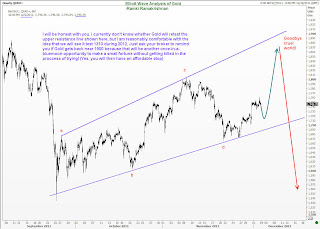 |
| NIFTY LONG TERM |
First and
foremost, Neowave novices like me must know something about the 7-legged pattern
called “Diametric”. In the words of the discoverer Glen Neely himself –
These patterns began to appear in the early 90's as the
market's way to adjust to the increasing popularity of wave theory (too many
people were looking for the same things, so the market created new ways of
behaving).
They were the first patterns witnessed where most wave
segments took about the same amount of time, with one or two of the waves
consuming a little more (or little less) time than the others.
While most waves consume a similar amount of time,
they do NOT consume a similar amount of price. A Diametric will possess an
obvious expansionary or contractionary bias during the first four waves of the
pattern; that bias will reverse during the second half of the formation.
It is called "Diametric" because it combines two
Triangular patterns, one initially “Contracting” up to the "d" leg,
followed by an “Expanding” one. The contraction point is the "d"
leg, and the legs on either sides of it tend to be equal.
To measure
& compare price moves in a long-term scenario, it is advantageous to go to
percentages.
Let’s check it –
Let’s check it –
 |
| NIFTY 1992 -2001 |
Coming to the 2008 onwards scenario now, we find the time-similarity again, where 3 out of 4 legs (A, C & D) have taken nearly the same time.
Another very interesting thing – the total time taken for the first 4 legs (A to D) for both the instances are the same – 66-68 months.
Price-wise –
 |
| NIFTY 2008- 2017 |
The
implication? The next year & half is going to be a grind, trying everyone’s
patience, a virtual nightmare for traders and investors alike. Only very
nimble-footed traders may survive. Trend-following strategies may under-perform
for this period but could be back with a bang after this, whenever the F leg
starts.
IF all
these come true, then we are going to witness one of the finest rallies from
the second half of 2014 or early 2015. This also matches nicely with the 8 year
cycle, giving us a projected top at 2016. Then a vicious bear market which
would precede the next mega-bull market. The final bottom could be anytime
between 2017 & 2019.
The red
channel can’t be overlooked. It contains the whole secular bull market. Irrespective
of the Diametric scenario coming true or not, whenever Nifty touches the
channel, expect a MAJOR multi-year move.
The median
line of channel (thick green line) has worked nice & clean after 2001. A break
of that line has always created a swift move, in any direction, since then.
Currently it is at around 5300. Keep watch.
CREDIT: FIRE








